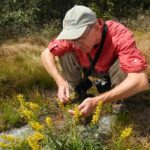Fight invasive species on Appalachian Trail land
We rely heavily on volunteers to monitor and control invasive plants along the A.T. Each year, several workshops are held to educate people about these species and how to address the problem of invasive plants. We have adopted an inventory protocol modeled after the reporting guidelines on the Early Detection and Distribution Mapping Systems (EDDMapS) website. This user-friendly system allows us to collect and share data with all of its partners.
Once invasive plants are identified along the Trail, the ATC and volunteers organize work projects to control the highest priority infestations. Priority is given to areas where rare plants or other sensitive resources occur and where new invasive plant infestations can be easily controlled before they spread.
What are Invasive Species?
Non-native invasive species are those that do not naturally occur in a certain area and are capable of causing ecological damage when introduced into a native ecosystem. Not all non-native species are invasive, but some have the ability to spread rapidly without the natural enemies from their home range. This allows them to spread rapidly and out-compete native vegetation, which increases their ability to spread.
By invading healthy ecosystems, invasive plants can replace complex forest communities with single species mono-cultures and can reduce the diversity of food supply and habitats available for native wildlife. Invasive species can interfere with essential ecosystem processes such as nutrient cycling, water filtration and fire regimes. Invasive species diminish the ability of ecosystems to sustain economic activities like forestry, fishing and agriculture, and they reduce the aesthetic value of a naturally diverse landscape.
Non-native invasive species can be spread by water, wind and animals, but seeds can also be transported on the shoes, clothing, and equipment of Trail users. It is important to educate yourself about how recreational activities can contribute to the proliferation of invasive species.
Resources
Check out these online resources to learn more about invasive species on the A.T.








